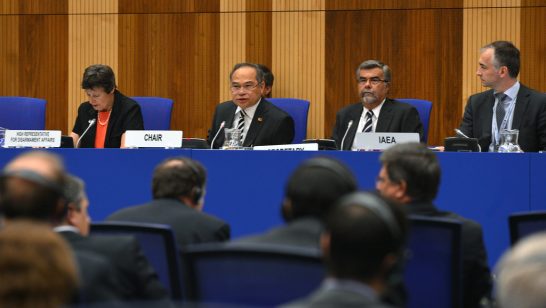
Nuclear developments in India and Pakistan are scaling new heights of technical maturity. Recent landmarks include the Indian test of the 5,000km Agni-V ballistic missile; deployment of the indigenous Arihant nuclear-armed submarine; and Pakistan’s test of the Nasr tactical nuclear missile and construction of new plutonium production complexes. These ambitious projects, with momentous consequences for their defence profiles, coincide with an increasing focus on internal issues in their domestic polities and resultant halting and distracted initiatives to improve their bilateral relationship. As their nuclear ambitions create new challenges for building a stable relationship, new efforts are needed from Islamabad and New Delhi to rejuvenate cross-border diplomacy in order to balance their nuclear ambitions with their economic and conventional force needs.
Bilateral Relations: Tense Stalemate
The bilateral relationship remains characterised by mutual mistrust. The Indian United Progressive Alliance (UPA-2) government, in office since 2009, has made cautious attempts to build rapport with Islamabad. These include quiet, private visits by Pakistan Prime Minister Yousuf Gilani to India in 2011, and by Gilani’s successor, Raja Pervez Ashraf, in March. However, high-profile peace talks or bold diplomatic initiatives, along the lines of the Lahore and Agra summits organised by the previous Indian National Democratic Alliance government in 1999 and 2001, have been avoided. The character of UPA-2 is allergic to the kind of political risk-taking these efforts would entail, while inwardly focused on the day-to-day management of its fractious governing coalition and on lifting India’s anaemic economic growth rate.
However, the extreme caution of the Indian government toward Pakistan also extends to its responses to armed Pakistani provocations. At each new incident, most recently a series of crossborder skirmishes in January 2013, the government comes under immense domestic pressure from its cacophonous media to teach Pakistan a lesson. Although the external restraint of New Delhi in the face of such domestic stress is commendable, pressure continues to mount on the government to deal more robustly with Pakistan the next time something happens. These sentiments are reinforced by the absence of a substantive Indian peace initiative to change this political context. As the Indian polity is now focused on political campaigning ahead of national elections in 2014, there is little prospect of near-term change to this posture toward Pakistan absent a truly catastrophic incident.
The substantial attention granted to Pakistan in Indian domestic politics is not mirrored in Pakistan. Pakistan’s media and domestic polity are fixated not upon the “India threat”, but upon the greatest actual threat to Pakistan’s future: its growing internal instability. The Supreme Court has claimed that Karachi, Pakistan’s largest city, has suffered over 5,000 murders since 2008. Armed attacks on military bases, some of which host elements of Pakistan’s nuclear arsenal, are becoming more sophisticated.
This popular preoccupation with domestic problems and inattention to Indian relations amplifies the already substantial autonomy that Pakistan’s military and intelligence services (colloquially “the establishment”) enjoy over security policy. Elected civilian leaders simply lack the domestic authority to negotiate and agree the terms of a new bilateral relationship with India without a prior green light from the establishment. Nawaz Sharif’s Pakistan Muslim League-N (PML-N) party, recent victors in the national elections in May, is well aware that better terms with India require first curtailing the establishment’s influence over bilateral relations, an immensely risky and difficult endeavour.
Nuclear Developments: Ambitious Expansion
This seeming stasis in Indo-Pakistani relations contrasts with their energetic nuclear force development. Both states continue to expand their warhead stockpiles, delivery vehicle capabilities and numbers, and supportive military nuclear infrastructure. India’s efforts to actualise its nuclear triad of land, air and sea forces, as envisioned in its draft nuclear doctrine of 1999, are beginning to bear fruit. Although the air forces, as the oldest leg of the triad, are well-established through nuclear gravity bombs, the naval contingent is now taking shape through the Arihant, the first of a fleet of nuclear-armed submarines, as well as the Dhanush ship-launched ballistic missile. Building and deploying the fleet will take substantial time, however, with one projection estimating that the full triad will not be deployed until 2030-2040.
India’s missile portfolio, forming the land leg of the triad, continues to expand and diversify. India tested the Agni-V missile, able to reach Chinese east coast metropolitan targets, in April 2012, and an even longer-range Agni-VI is being researched. At the other end of the range scale, a conventional tactical missile, the Prahaar, is being developed, which could open technical doors to an Indian tactical nuclear capability. These latter developments invite questions as to the continued accuracy of “credible minimum deterrence” as a descriptive doctrinal term for India’s nuclear force.
Pakistan’s nuclear arsenal development proceeds at a greater pace than India, partly driven by perceived nuclear infrastructural advantages that India gained through its 2008 nuclear agreement with the United States. It is estimated to have 90-110 warheads to India’s 60-80 warheads. Pakistan is developing its plutonium warhead capacity through two new plutonium production complexes at Khushab, and similarly to India is developing a mix of long-range and tactical missiles. The recently developed tactical Nasr missile, commissioned as a response to the Indian army’s interest in conventional limited war, creates numerous operational and strategic concerns, ranging from its actual utility in a conflict to security dangers associated with dispersal and management of the armed missiles in the field.
Conclusion
Both nuclear forces require urgent review by their political masters, as they are reaching important junctures in destructive capability, political and doctrinal roles and geographical reach. However, India and Pakistan are both ensconced in domestic political introspection as result of their electoral seasons. The next leaders should redouble efforts to promote cross-border investment and trade as the most realistic chance of long-term improvement in relations; introduce new nuclear confidence-building measures; and review the precepts and force methodologies of their nuclear doctrines, as balanced against their domestic economic troubles and conventional force needs.
The opinions articulated above represent the views of the author(s), and do not necessarily reflect the position of the European Leadership Network or any of its members. The ELN’s aim is to encourage debates that will help develop Europe’s capacity to address the pressing foreign, defence, and security challenges of our time.



